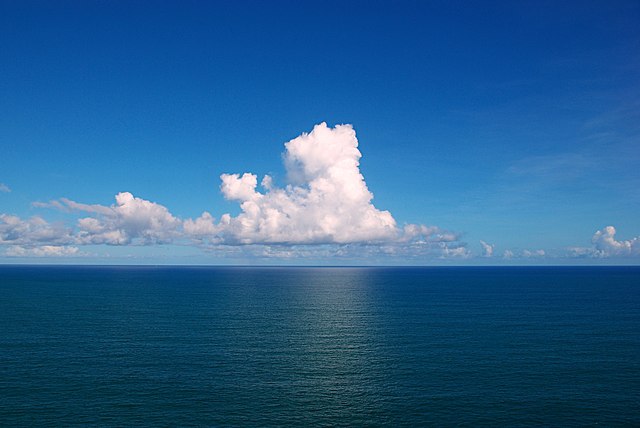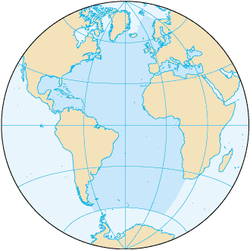Atlantic Ocean
ocean between Europe, Africa and the Americas From Wikipedia, the free encyclopedia
Remove ads
The Atlantic Ocean is the world's second largest ocean. It covers a total area of about 106,400,000 square kilometres (41,100,000 square miles), about 20 percent of the Earth's surface.[1]

It is named after the Ancient Greek god Atlas, the Titan in Greek mythology.
Remove ads
Geologic history
The Atlantic formed when the Americas moved west from Eurasia and Africa. This began sometime in the Cretaceous peiod, roughly 135 million years ago. It was part of the break-up of the supercontinent Pangaea.[2]
The East Coast of South America is shaped somewhat like the West Coast of Africa, which gave a clue that continents have moved over long periods of time in what is called continental drift. The Atlantic Ocean is still growing because of seafloor spreading from the Mid-Atlantic Ridge,[3] and the Pacific Ocean is shrinking because the sea floor is subducting, or folding under itself, into the mantle.
Remove ads
Geography
The Atlantic Ocean is bounded on the west by North and South America. It connects to the Arctic Ocean through the Denmark Strait, Greenland Sea, Norwegian Sea, and Barents Sea.[2] It connects with the Mediterranean Sea through the Strait of Gibraltar.[4]
In the southeast, the Atlantic merges into the Indian Ocean. The 20th meridian east defines its border.[4]
In the southwest, the Drake Passage connects it to the Pacific Ocean. The Panama Canal links the Atlantic and Pacific.[2]
The Atlantic Ocean is the largest ocean after the Pacific and had an area of 106,400,000 square kilometres (41,100,000 sq mi). The volume of the Atlantic, along with its bordering seas, is 354,700,000 cubic kilometres.[4]
The average depth of the Atlantic, along with its bordering seas, is 3,339 metres (1,826 fathoms; 10,955 ft). The greatest depth is Milwaukee Deep near Puerto Rico, where it is 8,380 metres (4,580 fathoms; 27,490 ft) deep.[4]
The RMS Titanic currently rests at the bottom of the Atlantic Ocean.
Gulf Stream
The Atlantic Ocean has important ocean currents. One of them, called the Gulf Stream, flows across the North Atlantic.[5] Water gets heated by the sun in the Caribbean Sea and then moves northwest toward the North Pole, which makes France, the British Isles, Iceland, and Norway, all in Europe, much warmer in winter than Newfoundland and Nova Scotia, noth in Canada.[5] Without the Gulf Stream, the climates of northeast Canada and northwestern Europe might be the same because both places are about the same distance from the North Pole.[5]
There are also currents in the South Atlantic, but the shape of the sea makes it have a smaller effect on South Africa.
Remove ads
Geology
The main feature of the Atlantic Ocean's seabed is a large underwater mountain chain, the Mid-Atlantic Ridge, which runs from north to south under the ocean at the boundary of four tectonic plates: Eurasian, North American, South American, and African.[6] The ridge extends from Iceland in the north to about 58° south.[6]
The salinity of the surface waters of the open ocean ranges from 33 to 37 parts per thousand and varies by latitude and season.[7]
References
Other websites
Wikiwand - on
Seamless Wikipedia browsing. On steroids.
Remove ads

